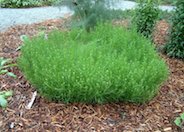
Common name:Green Lavender Cotton
Botanical name:Santolina rosmarinifolia
Santolina is an amazingly tough plant with small, yellow, button-sized flowers that cover the 3' tall and 3' wide shrub in the summer months. The green leaves are very thin and needle like. This plant requires absolutely no care in most environments once established. Too much water will lead to mortality. Best grown in well drained soils.
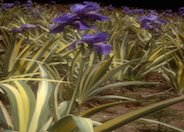
Common name:Zebra Iris, Orris Perfume Iris
Botanical name:Iris pallida 'Argentea Variegata'
This garden favorite is grown more for its striking silver variegated foliage than its fragrant blue blooms. Avoid intense heat and poor drainage. It is a deciduous plant.
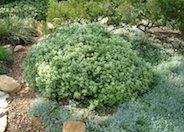
Common name:Compact Karo
Botanical name:Pittosporum crassifolium 'Compactum'
Pittosporum crassifolium 'Nana' is an evergreen shrub or tree. It can reach 25' tall and 20' wide in 8-10 years. Branches are densely clothed in gray green, with 1"-2" long leaves that have rounded ends. It produces maroon flowers in late spring.

Common name:Flowering Maple
Botanical name:Abutilon hybrids
Flowering Maple usually grow to 8'-10' tall and as wide. Most will tolerate frost to 25 degrees F or lower with some damage. All are irresistible to hummingbirds with their showy flowers and heavy nectar production. They will take sun to moderately deep shade and little or no summer watering in coastal areas. They should be given more shade and water in hotter, drier climates. They make an excellent plant for containers. -Monterey Bay Nursery
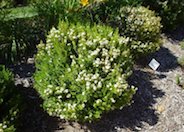
Common name:Compact Myrtle
Botanical name:Myrtus communis 'Compacta'
This evergreen shrub is 6' high and 5' wide with aromatic leaves. It blooms with white, sweet-scented flowers followed by bluish black berries. It can be grown in sun or partial shade; well drained soil is essential. 'Compacta' has smaller leaves and is often used for edges and low formal hedges.
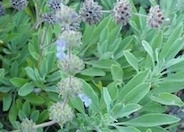
Common name:Sonoma Sage, Creeping Sage
Botanical name:Salvia sonomensis
This low growing, native groundcover has glaucous (covered with whitish, waxy material) green leaves with blue violet flowers that bloom in the spring and summer.
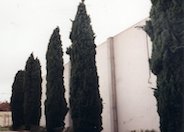
Common name:Italian Cypress
Botanical name:Cupressus sempervirens 'Stricta'
Italian Cypress is often associated with Italian and Spanish architecture, providing columns in the landscape. They often reach 60' tall. 'Stricta' is compact, columnar and produces long, straight branches with deep green foliage.
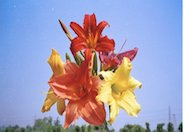
Common name:Hybrid Daylily (various)
Botanical name:Hemerocallis hybrids
These summer-blooming perennials form clumps with large, grass-like leaves. Its showy flowers, resembling lilies, are borne in clusters on stems held well above the foliage. They prefer full sun to light shade, well draining soil that is slightly acidic and rich. They do better with deep watering once a week. Daylilies make excellent cut flowers. Apply a layer of compost every fall.
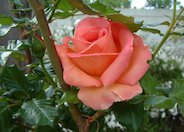
Common name:Hybrid Tea Rose (selections)
Botanical name:Rosa Hybrid Tea varieties
These shrubs and vines are the most loved in the Western USA and are very resilient. They come in a wide variety of sizes and colors and are easy to maintain with proper care. They can be used in a water-conserving garden with careful attention to irrigation practices.
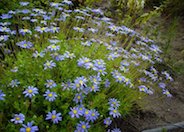
Common name:Blue Marguerite, Blue Felicia Daisy
Botanical name:Felicia amelloides
This shrubby perennial has oval leaves that are 1" in length and dark green in color. It produces a variety of bright blue, 1 1/4" wide flowers almost continuously, which resemble daisies.
| Designer: | Mediterranean Patio Arbor |
Photographer: GardenSoft |
Soils and Compost:
Incorporate compost 6" into your soil to retain water, reduce compaction, feed earthworms, and provide valuable nutrients to your plants.
Water Saving Tip:
Adjust sprinklers to avoid watering sidewalks and driveways.
Integrated Pest Management:
Develop healthy soil for plants that are vigorous and naturally pest-resistant.

